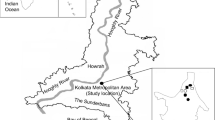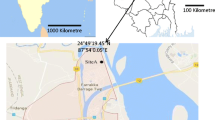Abstract
Fungal spores in ambient particulate matter (PM) is one of the major constituents which can adversely affect human health. For the first time, an investigation was conducted for 1 year at a residential region in north-east India to study the seasonal variation of PM10-associated fungal spore concentration and their diversity. Using fine particulate sampler, samples were collected at 12 h intervals for 1 week of every month during July 2016–June 2017. Twelve-hour averaged PM10 concentration was 79.74 μg/m3 and 103.47 μg/m3 during day and night time, respectively. Fungal spore concentration was 126 (54–294) CFU/m3 during day time and 107 (55 to 161) CFU/m3 during night time. Seven individual genera of fungal spores, namely Aspergillus, Penicillium, Cladosporium, Fusarium, Curvularia, Rhizopus, and Non-sporing isolates, were identified. Strong correlations between the Cladosporium and Penicillium (R = 0.83) and Cladosporium and Aspergillus (R = 0.82) were observed, which are well-known asthma allergens. Penicillium (30%), Fusarium (41%), and Aspergillus (25%) were the dominant fungi species in winter, monsoon, and summer seasons, respectively. Fungal spore concentrations peaked during summer and were least during monsoon. Fungal concentrations were negatively correlated with precipitation (R = − 0.25). Fungal counts had more significant positive correlation with temperature in non-rainy samples (R = 0.80), compared to negligible correlation (R = − 0.16) in all samples.







Similar content being viewed by others
References
Adams GC, Gottwald TR, Leach CM (1986) Environmental factors initiating liberation of conidia of powdery mildews, Phytopathology 76:1239–1245
Adhikari A, Sen MM, Gupta-Bhattacharya S, Chanda S (2004) Airborne viable, non-viable, and allergenic fungi in a rural agricultural area of India: a 2-year study at five outdoor sampling stations. Sci Total Environ 326:123–141
Agarwal MK, Shivpuri DN, Mukerji KG (1969) Studies on the allergenic fungal spores of the Delhi, India, metropolitan area: botanical aspects (aeromycology). J Allergy 44:193–203. https://doi.org/10.1016/0021-8707(69)90086-0
Aira M-J, Rodríguez-Rajo FJ, Fernández-González M, Seijo C, Elvira-Rendueles B, Abreu I, Gutiérrez-Bustillo M, Pérez-Sánchez E, Oliveira M, Recio M, Tormo R, Morales J (2013) Spatial and temporal distribution of Alternaria spores in the Iberian Peninsula atmosphere, and meteorological relationships: 1993–2009. Int J Biometeorol 57:265–274. https://doi.org/10.1007/s00484-012-0550-x
Anderson HR, Favarato G, Atkinson RW (2013) Long-term exposure to air pollution and the incidence of asthma: meta-analysis of cohort studies. Air Quality, Atmosphere Health 6:47–56
Angulo-Romero J, Mediavilla-Molina A, Domínguez-Vilches E (1999) Conidia of Alternaria in the atmosphere of the city of Cordoba, Spain in relation to meteorological parameters. Int J Biometeorol 43:45–49
Aydogdu H, Asan A, Otkun MT, Ture M (2005) Monitoring of fungi and bacteria in the indoor air of primary schools in Edirne city, Turkey. Indoor Built Environ 14:411–425
Aylor DE, Sutton TB (1992) Release of Venturia inaequalis ascospores during unsteady rain: relationship to spore transport and deposition. Phytopathology 82:532–540
Burge HA, Solomon WR, Muilenberg ML (1982) Evaluation of indoor plantings as allergen exposure sources. J Allergy Clin Immunol 70:101–108. https://doi.org/10.1016/0091-6749(82)90236-6
Bush RK, Portnoy JM (2001) The role and abatement of fungal allergens in allergic diseases. J Allergy Clin Immunol 107:S430–S440
Campbell CK, Johnson EM (2013) Identification of pathogenic fungi. John Wiley & Sons,
Chakrabarti HS, Das S, Gupta-Bhattacharya S (2012) Outdoor airborne fungal spora load in a suburb of Kolkata, India: its variation, meteorological determinants and health impact. Int J Environ Health Res 22:37–50
Chatterjee S, Saikia A, Dutta P, Ghosh D, Pangging G, Goswami AK (2006) Biodiversity significance of north East India WWF-India. New Delhi:1–71
Chowdhery HJ (2001) Orchid diversity in North-East India vol 15
Denning D, O'driscoll B, Hogaboam C, Bowyer P, Niven R (2006) The link between fungi and severe asthma: a summary of the evidence. Eur Respir J 27:615–626
Després V, Huffman JA, Burrows SM, Hoose C, Safatov AS, Buryak G, Fröhlich-Nowoisky J, Elbert W, Andreae MO, Pöschl U, Jaenicke R (2012) Primary biological aerosol particles in the atmosphere: a review. Tellus B: Chemical Physical Meteorology 64:15598
Douwes J, Thorne P, Pearce N, Heederik D (2003) Bioaerosol health effects and exposure assessment: progress and prospects. Annals Occupational Hygiene 47:187–200
Egan C, Li D-W, Klironomos J (2014) Detection of arbuscular mycorrhizal fungal spores in the air across different biomes and ecoregions. Fungal Ecol 12:26–31
Elbert W, Taylor P, Andreae M, Pöschl U (2007) Contribution of fungi to primary biogenic aerosols in the atmosphere: wet and dry discharged spores, carbohydrates, and inorganic ions. Atmos Chem Phys 7:4569–4588
Emberlin J, Newman T, Bryant R (1995) The incidence of fungal spores in the ambient air and inside homes: evidence from London. Aerobiologia 11:253–258
Fang Z, Ouyang Z, Hu L, Wang X, Zheng H, Lin X (2005) Culturable airborne fungi in outdoor environments in Beijing, China. Sci Total Environ 350:47–58
Fitt GP (1989) The ecology of Heliothis species in relation to agroecosystems. Annu Rev Entomol 34:17–53
Gielen MH, Van Der Zee S, Van Wijnen J, Van Steen C, Brunekreef B (1997) Acute effects of summer air pollution on respiratory health of asthmatic children. Am J Respir Crit Care Med 155:2105–2108
Gollapalli M, Kota SH (2017) Methane emissions from a landfill in north-east India: Performance of various landfill gas emission models. Environ Pollution 234:174–180
Gottwald TR (1982) Spore discharge by the pecan scab pathogen, Cladosporium caryigenum. Phytopathology 72:1193–1197
Green BJ, Mitakakis TZ, Tovey ER (2003) Allergen detection from 11 fungal species before and after germination. J Allergy Clin Immunol 111:285–289
Guo H, Kota SH, Sahu SK, Hu J, Ying Q, Gao A, Zhang H (2017) Source apportionment of PM2.5 in North India using source-oriented air quality models environmental pollution 231:426-436 doi:https://doi.org/10.1016/j.envpol.2017.08.016
Hasnain SM (1993) Influence of meteorological factors on the air spora. Grana 32:184–188
Hawkes CV, Kivlin SN, Rocca JD, Huguet V, Thomsen MA, Suttle KB (2010) Fungal community responses to precipitation. Glob Chang Biol 17:1637–1645. https://doi.org/10.1111/j.1365-2486.2010.02327.x
Ho H-M, Rao CY, Hsu H-H, Chiu Y-H, Liu C-M, Chao HJ (2005) Characteristics and determinants of ambient fungal spores in Hualien, Taiwan. Atmos Environ 39:5839–5850
Horner W, Helbling A, Salvaggio J, Lehrer S (1995) Fungal Allergens Clinical Microbiology reviews 8:161–179
Huang C-Y, Lee C-C, Li F-C, Ma Y-P, Su H-JJ (2002) The seasonal distribution of bioaerosols in municipal landfill sites: a 3-yr study. Atmos Environ 36:4385–4395
Jones AM, Harrison RM (2004) The effects of meteorological factors on atmospheric bioaerosol concentrations—a review. Sci Total Environ 326:151–180
Kakde UB, Kakde HU, Saoji AA (2001) Seasonal variation of fungal propagules in a fruit market environment. Nagpur (India) Aerobiologia 17:177–182
Kakikawa M, Kobayashi F, Maki T, Yamada M, Higashi T, Chen B, Shi G, Hong C, Tobo Y, Iwasaka Y (2008) Dustborne microorganisms in the atmosphere over an Asian dust source region, Dunhuang. Air Quality, Atmosphere Health 1:195–202. https://doi.org/10.1007/s11869-008-0024-9
Kallawicha K, Tsai YJ, Chuang YC, Lung SCC, Wu CD, Chen TH, Chen PC, Chompuchan C, Chao HJ (2015) The spatiotemporal distributions and determinants of ambient fungal spores in the greater Taipei area. Environ Pollut 204:173–180
Kota SH, Guo H, Myllyvirta L, Hu J, Sahu SK, Garaga R, Ying Q, Gao A, Dahiya S, Wang Y, Zhang H (2018) Year-long simulation of gaseous and particulate air pollutants in India. Atmos Environ 180:244–255. https://doi.org/10.1016/j.atmosenv.2018.03.003
Kumar A, Attri AK (2016) Characterization of fungal spores in ambient particulate matter: a study from the Himalayan region. Atmos Environ 142:182–193
Langenberg W, Sutton J, Gillespie T (1977) Relation of weather variables and periodicities of airborne spores of Alternaria dauci. Phytopathology 67:879–883
Larsen GL, Beskid C, Shirnamé-Moré L (2002) Environmental air toxics: role in asthma occurrence? Environ Health Perspect 110:501–504
Leach CM (1975) Influence of relative humidity and red-infrared radiation on violent spore release by Drechslera turcica and other fungi. Phytopathology 65:1303–1312
Li D-W, Kendrick B (1994) Functional relationships between airborne fungal spores and enviromental factors in Kitchener-Waterloo, Ontario, as detected by canonical correspondence analysis. Grana 33:166–176
Li X, Wang Y, Guo X, Wang Y (2013) Seasonal variation and source apportionment of organic and inorganic compounds in PM2. 5 and PM10 particulates in Beijing, China. J Environ Sci 25:741–750
Lin W-H, Li C-S (2000) Associations of fungal aerosols, air pollutants, and meteorological factors. Aerosol Sci Technol 32:359–368
Madelin T, Johnson H (1992) Fungal and actinomycete spore aerosols measured at different humidities with an aerodynamic particle sizer. J Appl Microbiol 72:400–409
Moore-Landecker E (2011) Fungal Spores. In: eLS. John Wiley & Sons, Ltd. doi:https://doi.org/10.1002/9780470015902.a0000378.pub2
Nasir ZA, Colbeck I, Sultan S, Ahmed S (2012) Bioaerosols in residential micro-environments in low income countries: a case study from Pakistan. Environ Pollut 168:15–22
Navi S, Bandyopadhyay R, Hall A, Bramel-Cox P (1999) A pictorial guide for the identification of mold fungi on sorghum grain. vol 59. International Crops Research Institute for Semi Arid Tropics,
O'Hollaren MT, Yunginger JW, Offord KP, Somers MJ, O'Connell EJ, Ballard DJ, Sachs MI (1991) Exposure to an aeroallergen as a possible precipitating factor in respiratory arrest in young patients with asthma. N Engl J Med 324:359–363
O’Gorman CM, Fuller HT (2008) Prevalence of culturable airborne spores of selected allergenic and pathogenic fungi in outdoor air. Atmos Environ 42:4355–4368
Portnoy JM, Kwak K, Dowling P, VanOsdol T, Barnes C (2005) Health effects of indoor fungi. Ann Allergy Asthma Immunol 94:313–320
Pringle A (2013) Asthma and the diversity of fungal spores in air. PLoS Pathog 9:e1003371
Prussin AJ, Marr LC (2015) Sources of airborne microorganisms in the built environment. Microbiome 3:78. https://doi.org/10.1186/s40168-015-0144-z
Rajan K. Chakrabarty MAG, Eric M. Wilcox and Hans Moosmülle (2012) India: Guwahati One of the most polluted city in the World, Available: http://chimalaya.org/2012/06/28/india-guwahati-one-of-the-most-polluted-city-in-the-world/ (Accessed 30 Nov, 2017)
Reddy KS, Shah B, Varghese C, Ramadoss A (2005) Responding to the threat of chronic diseases in India. Lancet 366:1744–1749
Rohr AC, Habre R, Godbold J, Moshier E, Schachter N, Kattan M, Grunin A, Nath A, Coull B, Koutrakis P (2014) Asthma exacerbation is associated with particulate matter source factors in children in new York City. Air Quality, Atmosphere Health 7:239–250
Sabariego S, De La Guardia CD, Alba F (2000) The effect of meteorological factors on the daily variation of airborne fungal spores in Granada (southern Spain) international. J Biometeorology 44:1–5
Sahu SK, Kota SH (2017) Significance of PM2.5 air quality at the Indian capital. Aerosol Air Qual Res 17:588–597. https://doi.org/10.4209/aaqr.2016.06.0262
Schachter EN, Moshier E, Habre R, Rohr A, Godbold J, Nath A, Grunin A, Coull B, Koutrakis P, Kattan M (2016) Outdoor air pollution and health effects in urban children with moderate to severe asthma. Air Quality, Atmosphere Health 9:251–263. https://doi.org/10.1007/s11869-015-0335-6
Singh A, Ganguli M, Singh A (1995) Fungal spores are an important component of library air. Aerobiologia 11:231–237
Timmer LW, Solel Z, Gottwald TR, Ibañez AM, Zitko SE (1998) Environmental factors affecting production, release, and field populations of conidia of Alternaria alternata, the cause of Brown spot of Citrus. Phytopathology 88:1218–1223. https://doi.org/10.1094/PHYTO.1998.88.11.1218
Womiloju TO, Miller JD, Mayer PM, Brook JR (2003) Methods to determine the biological composition of particulate matter collected from outdoor air. Atmos Environ 37:4335–4344
Acknowledgements
Authors would like to thank the ministry of human resources development, India.
Funding
This work is funded by the Department of Science and Technology of India (ECR/2016/000087).
Author information
Authors and Affiliations
Corresponding author
Rights and permissions
About this article
Cite this article
Garaga, R., Avinash, C.K.R. & Kota, S.H. Seasonal variation of airborne allergenic fungal spores in ambient PM10—a study in Guwahati, the largest city of north-east India. Air Qual Atmos Health 12, 11–20 (2019). https://doi.org/10.1007/s11869-018-0624-y
Received:
Accepted:
Published:
Issue Date:
DOI: https://doi.org/10.1007/s11869-018-0624-y




